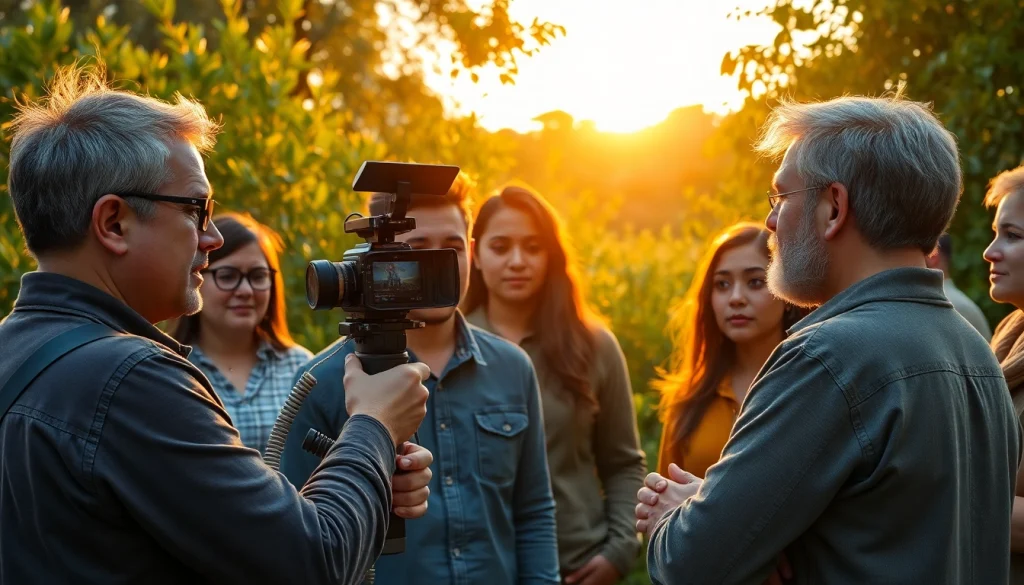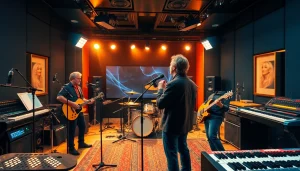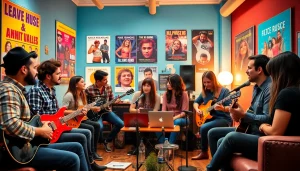Mastering the Techniques of Storytelling & Documentary for Impactful Visual Narratives

Understanding Storytelling & Documentary
In the world of visual media, storytelling and documentary filmmaking are two of the most powerful tools for capturing and communicating reality. They combine not only images and sounds but also human experiences and emotions to present a narrative that can inform, entertain, and inspire audiences. While both storytelling and documentary filmmaking share common elements, they stand apart in their techniques and intended outcomes. At the heart of effective storytelling lies the ability to connect with an audience on a deep level, eliciting empathy and understanding through engaging narratives. This exploration into Storytelling & Documentary will delve into the art, techniques, challenges, and emerging trends that shape these disciplines.
Defining the Art of Documentary Storytelling
Documentary storytelling aims to document real-life events, people, and cultures truthfully while also imparting a compelling narrative. Unlike fictional films, documentaries seek to present facts and perspectives authentically, allowing the audience to engage with real stories in a way that resonates with their own experiences. This art form relies on various storytelling techniques, including interviews, archival footage, and observational filming, to create a seamless and engaging narrative. Ultimately, great documentary storytelling not only informs but also captivates and stirs emotions, allowing the viewer to reflect on their understanding of the world.
Historical Context and Evolution of Documentary Films
The history of documentary films can be traced back to the early 20th century, evolving from a simple means of recording reality into an influential art form. The birth of documentary can be viewed through significant stages, beginning with early filmmakers who sought to capture events as they happened. Over the decades, the genre has transformed through various movements, such as the Direct Cinema of the 1960s and the rise of observational films that emphasize the unscripted and authentic experience of life. As technology advanced, so did the capability for more nuanced and complex narratives, drawing in diverse audiences and changing perceptions of reality. Today, the role of documentaries has expanded significantly, with platforms like streaming services breathing new life into the genre and reaching a broader demographic than ever before.
Key Principles of Effective Storytelling & Documentary
When approaching both storytelling and documentary filmmaking, several key principles should guide the process:
- Authenticity: The backbone of documentary storytelling is its commitment to truth. Audiences gravitate toward stories that feel real, relatable, and honest.
- Emotional Resonance: Effective storytelling taps into emotions, allowing audiences to connect with the characters and themes on a personal level.
- Structure: Like any narrative, documentaries benefit from a clear structure, often employing the classic beginning, middle, and end framework to guide the audience’s experience.
- Clarity: A successful documentary should present its message clearly, effectively communicating complex ideas in an understandable and engaging manner.
- Visual Imagery: The use of compelling visuals is critical in both storytelling and documentaries. Strong imagery captures attention and enhances the narrative’s impact.
Essential Techniques in Storytelling & Documentary
Visual Techniques to Enhance Storytelling
The visual dimension of storytelling and documentaries is instrumental in conveying meaning and emotion. Several techniques can be employed to amplify the visual narrative:
- Framing and Composition: Carefully considered shots and angles can emphasize a subject’s importance and convey emotional weight.
- Color and Mood: The use of color palettes can influence viewers’ emotional responses, underscoring the thematic elements of the narrative.
- Symbolism: Employing visual symbols can add layers of meaning, allowing audiences to engage with the content on a deeper level.
- Slow Motion and Time Lapse: These techniques can highlight critical moments in storytelling, enhancing the impact and allowing for dramatic emphasis.
Incorporating Sound and Music for Emotional Impact
Sound design and music play pivotal roles in enhancing the emotional depth of storytelling and documentaries. The strategic use of audio elements can elevate the viewer’s experience, aiding in both engagement and immersion:
- Diegetic Sound: Sounds that emanate from the film’s world (like dialogue, footsteps, or environmental sounds) contribute to the authenticity of a documentary.
- Non-Diegetic Music: Background music can influence an audience’s emotions significantly. Well-chosen scores can underscore tense moments, amplify joy, or underscore despair.
- Sound Effects: Creative use of sound effects can establish tone and enhance the storytelling experience, bringing the visuals to life.
Editing Strategies for Effective Narrative Flow
Edit decisions can make or break the effectiveness of a documentary or story. The editing process not only shapes the narrative’s pace but also influences its emotional trajectory:
- Continuity Editing: This technique maintains the illusion of continuous time and space, guiding viewers smoothly through the story.
- Montage: By juxtaposing images, editors can convey complex ideas visually and create contrasts that resonate emotionally.
- Rhythmic Editing: Changes in pace can evoke specific emotions; quick cuts can build excitement, while longer shots can create tension or contemplation.
Common Challenges in Storytelling & Documentary
Navigating Ethical Considerations in Filmmaking
Ethical considerations are paramount in documentary filmmaking. Filmmakers must often grapple with the responsibility of portraying their subjects truthfully and with respect. This involves obtaining informed consent from participants and representing their stories without manipulation or sensationalism. Ethical dilemmas may arise regarding the subjects being filmed; hence, filmmakers must always be conscious and respectful of personal and cultural boundaries. It is crucial for documentaries to honor the humanity of individuals featured, avoiding exploitation or objectification.
Overcoming Creative Blocks in Storytelling
Creative blocks can hinder the storytelling process, particularly in documentary filmmaking, where real-world complications can disrupt creative flow. To overcome these barriers, filmmakers can consider the following strategies:
- Collaboration: Engaging with other creatives can open new avenues of inspiration and perspective.
- Research and Exploration: Diving deep into the subject matter and exploring diverse viewpoints can enhance ideas and help generate new narratives.
- Mindfulness and Breaks: Taking time away from the project may provide fresh perspectives and alleviate pressure, allowing creativity to flourish.
Engaging Audiences and Driving Reactions
In an era where media consumption is saturated, holding an audience’s attention is more challenging than ever. Here are key tactics to engage viewers:
- Creating Relevant Content: Understanding target audiences and aligning the content’s themes and messages with their interests can enhance engagement.
- Evoking Emotion: Stories that trigger emotional responses can lead to more profound engagement and positive word-of-mouth recommendations.
- Interactive Elements: Incorporating polls, Q&A sessions, and social media interaction can enhance engagement and make the audience feel involved in the storytelling process.
Examples of Successful Storytelling & Documentary
Case Studies of Influential Documentaries
Several documentaries have stood out due to their exceptional storytelling and ability to resonate with audiences worldwide. Analyzing these can provide valuable insights into effective documentary filmmaking:
- “The Act of Killing”: This film’s unique approach, where former Indonesian death squad leaders reenact their real-life killings, challenges conventional storytelling by confronting uncomfortable truths.
- “13th”: Ava DuVernay’s documentary skillfully intertwines history and systemic racism, employing captivating visuals and strong narrative techniques to powerfully engage audiences.
- “Won’t You Be My Neighbor?”: This intimate portrait of Fred Rogers evokes emotional connections through a narrative that highlights compassion and kindness, underscoring the impact of storytelling beyond facts.
Analyzing Narrative Techniques in Film
Looking closely at narrative techniques employed in successful documentaries reveals effective strategies, such as:
- Personal Narratives: Inviting personal anecdotes can make the documentary relatable and foster emotional connections with the audience.
- Character Development: Developing characters throughout the narrative arcs invites viewers to invest emotionally in their journeys.
- Utilizing Intertitles and Voiceover: These elements can deepen understanding, providing context while enhancing emotional resonance through narration and commentary.
Lessons Learned from Renowned Filmmakers
Renowned filmmakers often share wisdom gained from their experiences, offering insights into successful storytelling and documentary techniques. Common lessons include:
- Stay True to the Story: Filmmakers emphasize the importance of remaining authentic to the narrative’s essence, ensuring that it reflects the subjects’ realities honestly.
- Embrace Vulnerability: Successful creators advocate for showing emotional honesty, which can lead to a more profound connection with audiences.
- Adaptability: Understanding that the story may shift throughout the filming process encourages flexibility, allowing documentary filmmakers to capture unexpected insights and developments.
Future of Storytelling & Documentary
Emerging Trends in Documentary Filmmaking
The landscape of documentary filmmaking is continuously evolving. Several trends are currently shaping the future of storytelling:
- Virtual Reality Experiences: Immersive documentaries using VR technology are creating dynamic ways for audiences to experience stories, engaging them on multi-sensory levels.
- Interactive Documentaries: These encourage audiences to take control of how they engage, allowing for various exploration paths and personalized experiences.
- Streaming Integration: The surge of documentaries on streaming platforms has broadened access, enabling diverse voices and stories that might once have been overlooked.
Technology’s Role in Evolving Storytelling Methods
Advancements in technology play a vital role in shaping new forms of storytelling and documentary creation:
- Simplified Filmmaking Tools: The availability of high-quality cameras and editing software has lowered barriers, empowering aspiring filmmakers to tell their stories.
- Data-Driven Storytelling: The use of analytics and audience metrics allows documentarians to understand viewer preferences and optimize narratives accordingly.
- Social Media Integration: Platforms like Instagram and Twitter create new avenues for sharing documentary shorts and engaging audiences in real time, fostering discussions surrounding the topics presented.
Preparing for Changes in Audience Engagement
As the media landscape shifts, so too do audience expectations and habits. To adapt, filmmakers should consider:
- Catering to Short Attention Spans: As audiences increasingly gravitate toward bite-sized content, filmmakers should consider structuring stories that resonate quickly without sacrificing depth.
- Fostering Community Engagement: Through active audience interaction and participation, filmmakers can create a sense of community around their content, enhancing the viewers’ investment in the story.
- Highlighting Diverse Perspectives: Ensuring representation of diverse voices in documentaries will engage new audiences and promote broader cultural conversations.







